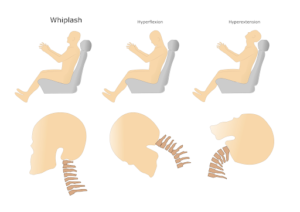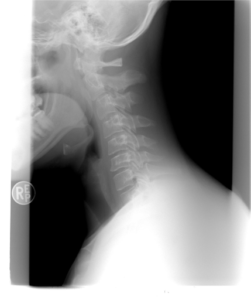Whiplash is a common injury to the neck that can be caused by car accidents or other trauma. Many people struggle with neck pain and headaches for years without knowing the cause. If whiplash is causing your pain, there are several safe and effective treatments that can help you feel like yourself again.
What is Whiplash?
Whiplash is an injury to the soft tissues and sometimes vertebrae of the neck. Any incident that involves rapid deceleration– such as getting rear-ended in a car accident– can cause whiplash. During this type of accident, the lower cervical vertebrae ( the bones at the base of the neck) are forced backward (hyperextension), and the upper cervical vertebrae ( the bones higher up in the neck) are forced forward (hyperflexion). This changes or reveres the normal C-shaped curve of the cervical spine (the bones in the neck) and often in soft tissue and nerve damage. The extent of damage may be assessed by X-ray or MRI depending on the severity of symptoms.
What are the Symptoms?
Symptoms of whiplash include:
-Neck Pain and stiffness
-Restricted range of motion in the neck
-fatigue
-dizziness
-shoulder pain and stiffness
-back pain
-arm pain
-arm weakness
-problems with vision
-ringing in the ears
-headaches
Some of the symptoms of whiplash are similar to the symptoms of a concussion. Often in car accidents or other causes of trauma, the victim may experience both a concussion and whiplash. Many people don’t realize theextent of injury or the lasting damage of a whiplash until weeks, months, or even years after the accident.
Since car accidents are the most common type of trauma associated with whiplash injuries, some people who’ve experienced other types of trauma don’t realize that whiplash may be behind their symptoms. Slips and falls, sports injuries, and anything else that causes a sudden jolt to the head can cause whiplash.
How is Whiplash Diagnosed?
Your doctor or chiropractor will do a physical examination and may ask you to move your head in specific ways to show her your range of motion. She may also ask you what types of movements hurt, and other questions about the nature of your pain. Usually, doctors will order an x-ray or an MRI. Flexion (bending forward) and extension (bending backward) X-ray images often demonstrate the areas most affected by whiplash. An MRI may be performed in severe cases to better visualized adhesion formation (scar tissue) or tearing of the soft tissue. Just because the x-ray does not show bone damage such as a broken bone, doesn’t mean you don’t have whiplash.
How is Whiplash Treated?
Many Urgent care facilities and primary care physcians will recommend over the counter pain medications to help control your pain. Some doctors may prescribe muscle relaxants for very short term use. These can help with pain and sleep during the initial recovery stage. In some cases of minor soft tissue injuries, the whiplash will heal on its own. If you experience symptoms for more than a few weeks or if an x-ray shows any spinal damage, you will need some type of Rehab to help you recover.
Many chiropractors offer specialized treatments for whiplash, since it is one of the most common traumatic injuries. Posture Rehab can be an effective tool along with chiropractic care to improve an acute or chronic whiplash. This therapy involves simple stretches and exercises designed to strengthen the muscles and re-train damaged ligaments and nerves. In cases where the cervical spine is out of alignment, your chiropractor may also use a specialized orthotic device that will help to move the vertebrae in your neck back into their proper curve.
One such devce is the Denneroll (pictured above.) Used with stretches and exercises, orthopedic devices like this one have been shown to be effective at correcting spinal curvature. If your whiplash injury included damage to spinal curvature, this needs to be corrected before your soft tissue injuries can properly heal. Otherwise, the misaligned vertebrae will continue to put stress on ligaments and other soft tissues in the neck.
After any needed spinal adjustments have been completed, other treatments can be used to speed the recovery of soft tissue damage. Procedures such as laser therapy and acoustic compression can increase blood flow to the injured area and help to speed the body’s healing process. If your whiplash injury happened years before treatment, acoustic compression therapy could be beneficial in breaking up old scar tissue. Both laser therapy and acoustic compression are non-invasive, FDA approved procedures. Many patients find that these treatments quickly improve the pain they’ve been living with for a long time.
Treatment for whiplash injuries doesn’t only happen during office visits. Your treatment provider should also have you perform some exercises at home. Depending on the severity of your injury, you may need to do these exercises several times a day. Following through on your home care is the best way to make sure your treatment is successful. You will also need to avoid activities, like riding roller coasters or playing certain sports, that can aggravate your injuries. Your doctor or chiropractor will be able to tell you how long you need to avoid these things.
Complications Of Whiplash Injuries
Sometimes whiplash injuries can result in nerve pain that takes longer to heal. The accident that caused your whiplash may also have caused other problems like herniated discs. If left untreated, arthritis can also occur at an accelerated rate. Additional treatments may be necessary to help with these complications, especially spinal arthritis, herniated discs, or nerve damage. Your doctor may recommend treatments like massage, acupuncture, nutritional support or spinal decompression therapy to help manage your pain while your body continues to heal. “










